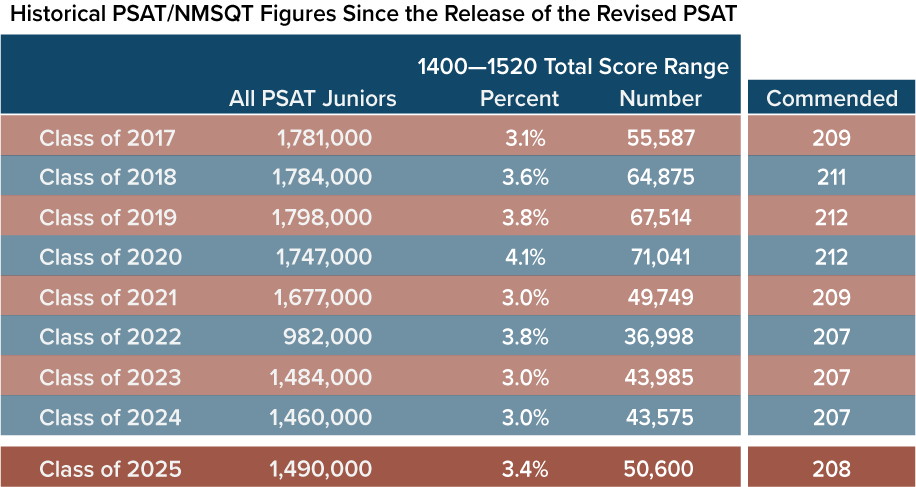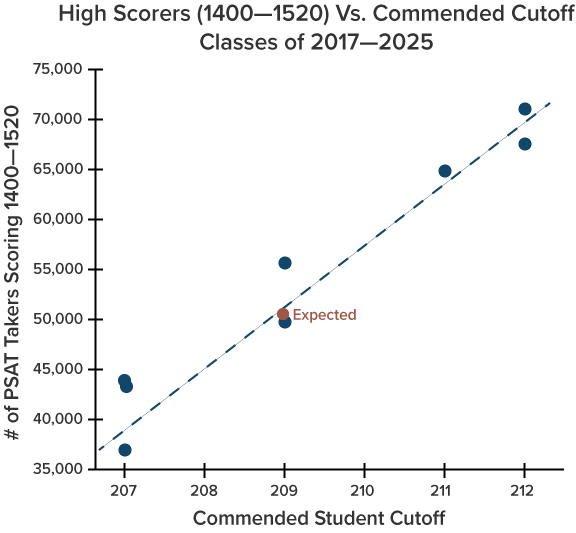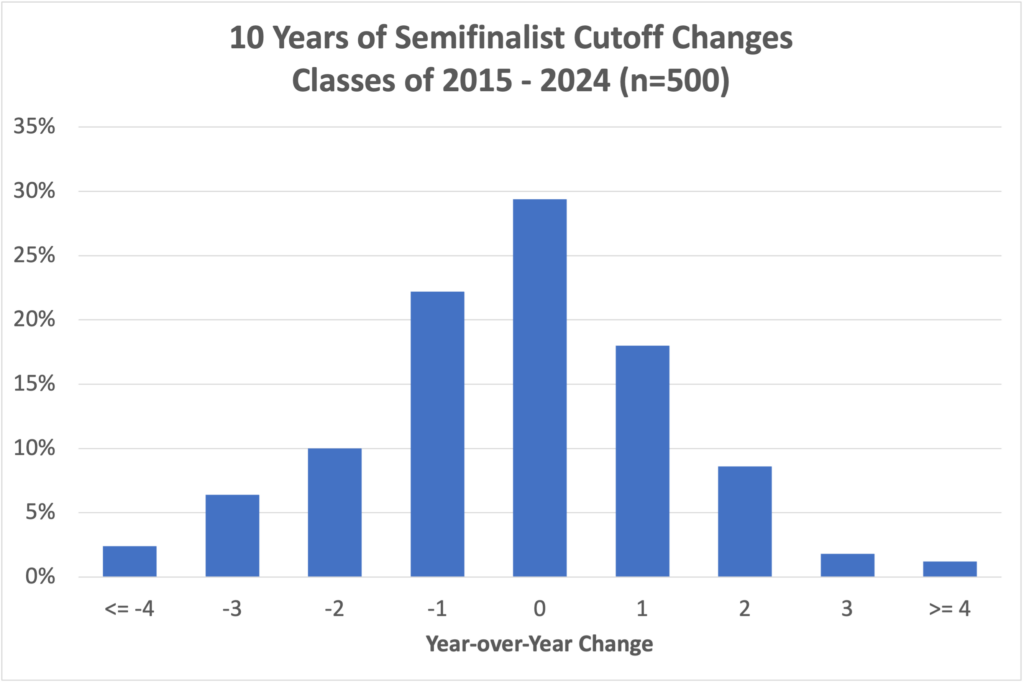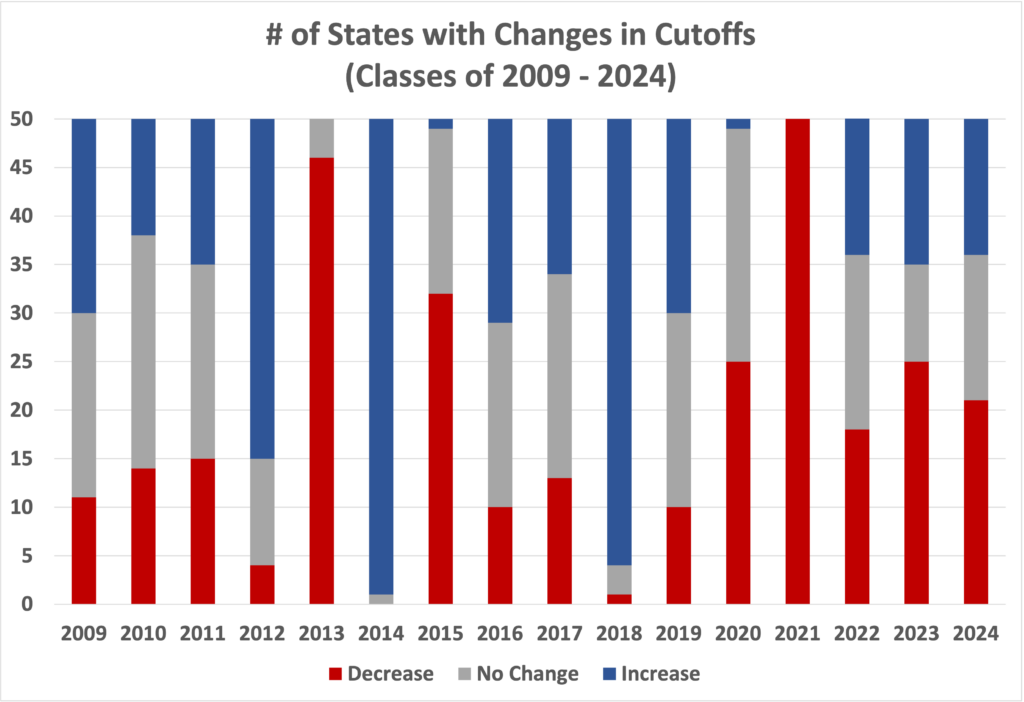
April 8 Update:
The Commended cutoff — the minimum score to be considered for National Merit honors — for the class of 2025 is 208. This is the highest cutoff in 4 years. Compass’s analysis of the results from the first digital PSAT showed that the Commended cutoff would fall in the 208 – 210 range, so the 208 is in line with expectations.
Compass has incorporated the Commended cutoff into its projections for the Semifinalist cutoffs, which will begin filtering out around Labor Day.
Why haven’t I been told anything by my school?
The April announcement is to schools only and is not an official notification of a student’s status. Honored students are not notified until September.
Why aren’t Semifinalist cutoffs announced at the same time?
National Merit must receive student eligibility information from schools and then calculate the separate Semifinalist cutoffs for each state. Only the Commended cutoff is national. NMSC will mail high schools the names of Semifinalists at the end of August, and students will be notified by their schools in early to mid-September. Schools are not given the Commended Student letters until after Semifinalists are announced.
[The November 2023 post below has been updated with the Commended cutoff information.]
The 2023 digital PSAT/NMSQT for the class of 2025 represents the biggest change to the National Merit Scholarship Program since the PSAT was overhauled in 2015. Each year Compass looks at the results from the PSAT and tracks projected Selection Index cutoffs for Commended Students and for Semifinalist in each of the 50 states. [See National Merit Scholarship Program Explained for full details on stages and instructions. For information on the class of 2024 cutoffs, see this archive.]
Instead of having schools administer a paper test on fixed dates, College Board allowed the digital PSAT to be offered throughout October. College Board also introduced a new score return policy. Students taking the test on or before October 14th receive scores on November 6th. Students taking the PSAT after October 14th receive their scores on November 16th. Compass now has the data from both release windows. Approximately 50,000 students landed in the 1400-1520 score band from almost 1.5 million test takers. The initial half of scores already accounted for 30,000 of top band scores, so the later testers had a lower proportion of high scorers. This will come as a relief to students who were fearing an extremely large jump in Selection Index cutoffs.
This year is shaping up similar to the class of 2021 (the last pre-pandemic PSAT) and, reaching back farther, the class of 2017.
The number of top scorers is the most critical piece of information that we get this early in the process. There is a strong correlation between the 1400-1520 band of students and the Commended Student score.
[We now know the exact Commended cutoff is 208. -Ed.] The Commended Student cutoff is likely to rise to 209 (above the 207 from the last 3 years). Estimates can be imperfect, but we are confident that the Commended cutoff will fall within the 208 to 210 range. The higher Commended cutoff, in turn, correlates with higher Semifinalist cutoffs. Below are those estimates.
| State | Class of 2025 (Most Likely) | Class of 2025 (Est Range) | Class of 2024 (Actual) | Class of 2023 (Actual) | Class of 2022 (Actual) |
|---|---|---|---|---|---|
| Alabama | 212 | 210 - 216 | 210 | 212 | 212 |
| Alaska | 212 | 209 - 215 | 209 | 210 | 208 |
| Arizona | 217 | 214 - 220 | 216 | 214 | 218 |
| Arkansas | 212 | 209 - 215 | 210 | 210 | 211 |
| California | 221 | 219 - 223 | 221 | 220 | 221 |
| Colorado | 217 | 215 - 220 | 216 | 217 | 217 |
| Connecticut | 221 | 219 - 222 | 221 | 221 | 220 |
| Delaware | 220 | 218 - 222 | 219 | 218 | 220 |
| District of Columbia | 223 | 222 - 224 | 223 | 223 | 224 |
| Florida | 216 | 215 - 219 | 216 | 216 | 217 |
| Georgia | 219 | 216 - 220 | 217 | 218 | 219 |
| Hawaii | 217 | 215 - 220 | 217 | 215 | 217 |
| Idaho | 214 | 210 - 216 | 211 | 215 | 214 |
| Illinois | 219 | 217 - 221 | 219 | 219 | 218 |
| Indiana | 216 | 213 - 219 | 216 | 214 | 215 |
| Iowa | 213 | 210 - 216 | 210 | 212 | 211 |
| Kansas | 215 | 213 - 218 | 214 | 214 | 215 |
| Kentucky | 214 | 210 - 217 | 211 | 212 | 212 |
| Louisiana | 214 | 211 - 217 | 214 | 213 | 213 |
| Maine | 214 | 211 - 217 | 213 | 215 | 211 |
| Maryland | 222 | 219 - 223 | 221 | 222 | 224 |
| Massachusetts | 222 | 220 - 223 | 222 | 220 | 221 |
| Michigan | 217 | 215 - 220 | 217 | 218 | 217 |
| Minnesota | 218 | 215 - 220 | 216 | 216 | 218 |
| Mississippi | 211 | 209 - 215 | 209 | 210 | 213 |
| Missouri | 215 | 212 - 218 | 214 | 213 | 214 |
| Montana | 210 | 208 - 214 | 209 | 207 | 208 |
| Nebraska | 213 | 209 - 216 | 210 | 212 | 210 |
| Nevada | 214 | 210 - 218 | 211 | 210 | 214 |
| New Hampshire | 215 | 213 - 219 | 215 | 213 | 214 |
| New Jersey | 223 | 222 - 224 | 223 | 223 | 222 |
| New Mexico | 211 | 208 - 214 | 207 | 208 | 210 |
| New York | 220 | 218 - 222 | 220 | 219 | 220 |
| North Carolina | 218 | 215 - 220 | 217 | 217 | 218 |
| North Dakota | 208 | 208 - 210 | 207 | 209 | 207 |
| Ohio | 216 | 214 - 218 | 216 | 216 | 215 |
| Oklahoma | 211 | 209 - 215 | 208 | 211 | 210 |
| Oregon | 217 | 215 - 220 | 216 | 216 | 220 |
| Pennsylvania | 219 | 217 - 221 | 219 | 218 | 218 |
| Rhode Island | 216 | 213 - 219 | 215 | 216 | 213 |
| South Carolina | 213 | 209 - 217 | 209 | 213 | 213 |
| South Dakota | 211 | 208 - 214 | 209 | 212 | 210 |
| Tennessee | 216 | 214 - 219 | 217 | 215 | 215 |
| Texas | 220 | 218 - 221 | 219 | 219 | 220 |
| Utah | 212 | 209 - 216 | 209 | 211 | 212 |
| Vermont | 213 | 210 - 217 | 212 | 213 | 211 |
| Virginia | 221 | 219 - 222 | 219 | 221 | 221 |
| Washington | 220 | 218 - 222 | 220 | 220 | 220 |
| West Virginia | 208 | 208 - 210 | 207 | 207 | 207 |
| Wisconsin | 214 | 212 - 217 | 213 | 213 | 214 |
| Wyoming | 208 | 208 - 210 | 207 | 207 | 208 |
| U.S. Territories | 208 | 208 | 207 | 207 | 207 |
| Studying Abroad | 223 | 222 - 224 | 223 | 223 | 224 |
| Commended | 208 | 208 | 207 | 207 | 207 |
[See Compass’s National Merit Historical Cutoffs post for data going back to the class of 2008, which can be helpful in comparing this year to its analogues.]
The shift to a shorter, online and adaptive exam is unlikely to wreak the havoc we saw when the “revised PSAT” was introduced 8 years ago. That test overhauled content AND scoring. The digital SAT represents a content change — mainly on Reading and Writing — but keeps the 320-1520 score range intact. The Selection Index, too, remains consistent, with the Reading and Writing score having twice the weight of the Math score.
However, for any given state, a change in cutoff is more likely than not. Historically, Semifinalist cutoffs remain unchanged only about one-third of the time.
Even in years where the Commended cutoff remains static, we see half of state cutoffs go up or down. And it is extremely improbable that the Selection Index will be static. The chart below divides the 50 states into those that saw increases (blue), those that remained unchanged (gray), and those that saw declines (red). We are likely to see a year with far more blue than gray and more gray than red.
Uncertainty around exactly which state cutoffs will change and by how much is why we encourage students to compare their scores to the full estimated range in the table above rather than to a single value (our “Most Likely”). These estimates are built from prior performance data and from data on what scores are doing nationally. State and national numbers are not always in alignment. Cutoffs are particularly bumpy in states with smaller pools of test takers and National Merit Semifinalists. Over the last 10 years, large states’ cutoffs have remained within 1 point of the prior cutoff 88% of the time. That figure drops to 73% for midsized states and 53% for small states. No large state’s cutoff has jumped by more than 3 points in a year, whereas 6-point changes have occurred in the pool of smaller states. Scores also tend to be more stable as they get higher. It is more unusual for a state to move from 221 to 222, for example, than for a state to move from 212 to 213.
What does a cutoff mean? Do I need to score at the cutoff or above it?
Students must have a Selection Index at or above the official cutoff in order to qualify for National Merit honors.
The top 52,000 to 54,000 students will receive some form of honors. National Merit Scholarship Corporation (NMSC) determines the cutoff number that comes closest to producing the target number of national honorees. This is the Commended cutoff.
How are Semifinalist cutoffs set?
Unlike the national Commended cutoff, Semifinalist cutoffs are calculated state by state. NMSC allocates the 16,000 semifinalists among states based on the annual number of high school graduates. For example, California sees about 2,000 Semifinalists every year, Michigan 500, and Wyoming 25. In each state, NMSC determines the Selection Index that comes closest to matching its target number of Semifinalists. If 1,900 California students score 222 and higher and 2,050 score 221 or higher, then the Semifinalist cutoff would be 221 (this assumes that the target is exactly 2,000). Because score levels can get crowded, it is easy for cutoffs to move up or down a point even when there is minimal change in testing behavior or performance.
No Semifinalist cutoff can be lower than the national Commended level. Cutoffs for the District of Columbia and for U.S. students studying abroad are set at the highest state cutoff (typically New Jersey). The cutoff for students in U.S. territories and possessions falls at the Commended level each year. Boarding schools are grouped by region. The cutoff for a given region is the highest state cutoff within the region.
Why does the number of top scorers vary from year to year?
While there are changes in the number of students taking the PSAT/NMSQT, there can also be small flaws in test scaling that play a role. Prior to the digital PSAT, a single test form was seen by a large percentage of test takers. Something amiss with that single form could impact selection cutoffs across the country. The digital PSAT is constructed differently. Students receive unique form codes drawn from a large pool of problems. Scaled scores are generated based on the characteristics of those problems. In theory, this should make scores more stable. College Board’s early studies have found an extremely high correlation between the paper-and-pencil test and digital test. Still, even with its adaptive nature, the uncertainty remains as to whether the much shorter test can reliably score students at the 700-760 end of the scale. It appears that the class of 2025 is roughly average compared to the classes of 2017 to 2024 (the years after the change from the 2400 to 1520 scale).
Will test cancellations raise or lower qualifying scores for the National Merit Scholarship Program?
College Board’s online systems failed under load on one of the biggest testing days. There was also a bug that prevented iPads on the latest operating system from submitting exams. We do not know how many schools or students simply gave up and did not retest on rescheduled dates. If the cancellations increase the number of students pursuing alternate entry (see Compass’s explanation of National Merit alternate entry) then cutoffs could rise. Alternate entrants tend to have higher scores, because they can submit SAT scores through June 2024 to enter the competition. They must apply by April.
When are National Merit Semifinalists announced?
The Commended cutoff becomes unofficially known by the end of April. The lists of Semifinalists are not distributed to high schools until the end of August. NMSC sets a press embargo on Semifinalist announcement until mid-September, but schools are allowed to notify students before that date. NMSC does not send Commended Student letters to high schools until mid-September. Compass will keep students updated on developments as those dates approach.
Do state and national percentiles indicate whether I will be a National Merit Semifinalist?
No! Approximately 1% of test takers qualify as Semifinalists each year, so it is tempting to view a 99th percentile score as indicating a high enough score — especially now that College Board provides students with percentiles by state. There are any number of flaws that rule out using percentiles as a quick way of determining National Merit status.
- Percentiles are based on section scores or total score, not Selection Index
- Percentiles are rounded. There is a large difference, from a National Merit perspective, between the top 0.51% and the top 1.49%
- Percentiles reveal the percentage of students at or below a certain score, but the “at” part is important when NMSC is determining cutoffs.
- The number of Semifinalists is based on the number of high school graduates in a state, not the number of PSAT takers. Percentiles are based on PSAT takers. States have widely varying participation rates.
- Most definitive of all: Percentiles do not reflect the current year’s scores! They are based on the prior 3 years’ performance. They are set even before the test is given. And if you are going to use prior history, why not use the completely accurate record of prior National Merit cutoffs rather than the highly suspect percentiles?
Entry requirements for National Merit versus qualifying for National Merit.
Your PSAT/NMSQT score report tells you whether you meet the eligibility requirements for the NMSP. In general, juniors taking the October PSAT are eligible. If you have an asterisk next to your Selection Index, it means that your answers to the entrance questions have made you ineligible. Your answers are conveniently noted on your score report. If you think there is an error, you will also find instructions on how to contact NMSC. Meeting the eligibility requirements simply means that your score will be considered. Approximately 1.4 million students enter the competition each year. Only about 52,000 students will be named as Commended Students, Semifinalists, Finalists, or Scholars. See National Merit Explained for more information.





Thanks for all the great information, Art! Any thoughts on a 218 in CO qualifying as a semifinalist for 2024?
Robert,
I divide the last 7 years into 3 high years and 4 low years when we look at trends across the county. In low years — and I think this is one — we’ve seen cutoffs of 217 and 218. In the high years, we’ve seen cutoffs of 220 and 221 in Colorado. So as long as this year plays out as low year, you are in good shape.
My daughter received 219 in Illinois . What are her chances to qualify for semi finalist? Thanks
Sarah,
Her chances depend on whether or not we see low scores consistently across the country. My research shows that we are likely to. In the 4 years with Commended levels under 210, Illinois’ cutoff has never gone above 219. In high years, the cutoff moved to 221. I’d peg your daughter’s chances as at least 2 out of 3, but it is close enough that she’ll need to wait until September to really know.
According to my calculations, my daughter got a 226 (760 verbal, 740 math). We are in Georgia. It looks like she qualifies to move forward. She took the SAT in May 2022 as a sophomore and received a 1430 (ACT 34 in June 2022). When will she know if that score is high enough for further National Merit consideration or if she should try to take the SAT again as a junior?
Lauren,
Congratulations to your daughter! Generally the confirming score is set as the Commended cutoff. So you calculate a Selection Index from the SAT score and want it to be over 212 (to be safe). You can also convert an ACT score to a Selection Index, but you’ll want to read our FAQ for full instructions. A 34 is almost certainly high enough (the Science is ignored, btw).
Hello Art,
What do you think the odds look like for a 218 in Kansas to become a semi-finalist? I’ve seen Kansas go above, but that was some time ago.
Mike,
We’ve only seen the cutoff in Kansas hit 219 once in the last 7 years and, crucially, that was a year where scores trended high across the country. My research shows that we are in a “low year,” so I think there is a very good chance that a 218 qualifies in KS.
Hi, my daughter got a 213 index for Louisiana. What do you think her chances are? Is it likely that the index cutoff will go up to 214/215? Thank you!
Molly,
In years where scores have trended low across the country, Louisiana has had cutoffs of 212, 213, 213, and 214. During high years, the cutoff has been as high as 219. While I believe the evidence strongly points to another low year, we can’t be certain that LA will stay at 213. I’d put your daughter’s chances somewhere between 50 and 75%.
Hi. Do you think that there is a good chance that Louisiana will stay at 213, drop, or go higher? Also, when will there be more information to update the predictions based on research or things that come out?
Haley,
I think the most likely case is a 213, but I would not be surprised by a 212 or 214. We saw a 212 as recently as the class of 2021. Louisiana has gone as high as 217, but that was in a year when scores were high across the country.
I have extracted most of the information I can from the PSAT data. National Merit is always tight-lipped about what it releases. The next major news is when we get a leak of the Commended cutoff. That usually occurs in April.
We are in CA, PSAT 224, SAT 227.5… Can you please be so kind letting me know if my son has a chance for semi finalist? Thank you so much!
MCG,
A 224 Selection Index will absolutely qualify in CA (or in any other state). Congratulations to your son! The SAT score will only matter as a requirement for Finalist selection. That score is also high enough. As far as National Merit is concerned, your son’s testing is done.
My son in CA received 1490 PSAT, with 222 NMSQT selection index. We’re worried about missing the selection index by only 1 (which would be a massive shame). Any thoughts on what may happen?
Kang,
While I can’t say that a 223 cutoff in CA could never happen (it did in the class of 2019), it would be extremely unlikely this year. Everything I’ve seen points to another year of low to modest cutoffs. It would be shocking if CA jumped 3 points (it never has).
Art,
Thank you so much for considering these questions. My son got a 222 in Nevada.
Congratulations to your son! He can sleep easily for the next 10 months.
Hey Art,
Thank you for providing this wonderful resource for NMSQT selection indices! How do you estimate when a year is low vs. high?
Emily
Emily,
Since the introduction of the new PSAT, there have been 7 classes, and they have fallen into two pools. There have been 3 years with over 60,000 1400-1520 scorers where the Commended cutoff is above 210 (“high year”) and 4 years with under 60,000 high scorers and Commended cutoffs below 210 (“low years”). From what I have seen of the College Board data, we are in a low year. In high years the average Semifinalist cutoff is 218. It is 215 in low years. Trends are not always nationwide, so individual states can move against the grain.
Hi Art,
Thanks for your diligent work in compiling this information! Will a 218 index score in MN be enough to qualify for being a semifinalist?
Luke,
I think a 218 in MN falls in the “more likely than not category.” I’d put it in the 50-75% range.
Appreciate this site! In Tennessee…my child scored an index of 216. The past few years has been a consistent 215 cutoff. *If* that number holds steady, would that mean (s)he’s commended or semifinalist or not necessarily either? Thank you!
Kelly,
Everyone at or above the cutoff (as long as they are eligible) qualifies as a Semifinalist. If things hold steady — or even go up a point — your student will qualify. If the cutoff in TN goes to 217, then your child would be a Commended student.
What are the odds of becoming a semi-finalist w/ a 217 in PA?
VN,
We’ve seen PA at 217 5 times in the last 15 years and I am confident that we are going to see low-ish scores across the board. I think 218 may be more likely, but there is still a chance with 217.
Hey Mr. Sawer,
I am in Texas and I got a 223 nmsqt score. For texas, I see the range is from 218 – 221. Am I completely safe? Or is there a chance that I will get knocked out?
You are completely safe. Congratulations!
Hi, we live in CA, my daughter got 220. Do you think she will be able to make the semi-finalist round? Thanks!
Vicki,
California surprised me a bit with its decline to 220. Maybe it should not have because there has been a general decline in test taking with the UCs now test free. I think 220 has a slightly better chance than 221 this year.
Hi Art!
Great article and research. Thoughts to an Ohio 215 for my child? Any chance they dip one point from last years 216 cutoff ?
Thanks!
We know a 215 is possible since that’s where it was for the classes of 2021 and 2022. Let’s hope that it moves back in that direction.
My daughter got 217 in Kansas. We are not very sure about her NMSF…still worrying…
Janet,
It’s not 100% given that Kansas has seen cutoffs of 218 and 219, but with the numbers indicating low cutoffs nationwide this year, your daughter’s chances are excellent.
Hi, My daughter received 219 in Texas. What are her chances to qualify for semi finalist? Thanks
Ratnaker,
I think there is a 50-75% chance that Texas will stay at 219 or lower.
Hi,
I received a 219 in TX. I’m really worried i will miss it by one point. Can you be honest and tell me my chances of getting 219 or lower as the cutoff in texas?
A,
Being honest, I think it is a toss-up. In the 4 years that we have seen a lower number of students getting 1400-1520 scores, twice TX has come in at 220 and twice at 219. I’d say that it’s good news that it came in at 219 last year.
What do you think the chances of making National Merit are with 215 index in Alabama?
Grace,
I think a 215 will qualify in Alabama. We’ve only seen a 216 in years where all of the cutoffs are quite high. This will not be that kind of year.
Thank you very much for all these information. Any comment on 1480 i.e. 221 in Maryland.? Last year it was 222. Do you see any possibility of low cutoff this year?
SR,
Maryland is something of a peculiar case. If we look at the 4 years where Commended cutoffs fell below 210, we find 2 years with 221, last year’s 222, and the 224 from two years ago. The class of 2022 figure really needs to be thrown out. Almost all PSATs were canceled in Maryland that year, and most students entered with SAT scores, instead. At worst, we can say that Maryland’s cutoff has been 221 in half of the low years. So, yes, I do think it is a legitimate possibility that the MD cutoff drops to 221.
Why the cutoff is different in different states.? If we call it National Merit Test, then cutoff should be same for all states. Otherwise, it should be called State level merit scholarship test.
SR,
Yes, this is a common complaint. One thing to consider is that, on a practical level, certain states — especially those with high PSAT-taking numbers — would dominate the Semifinalist counts and it would be harder for NMSC to appeal to the corporations and colleges that support it.
Hello Art, My kid has a composite PSAT score of 207. His ERW is 97%, math 99%. Would that mean he has a great chance to become a commended? Thanks.
Jean,
It seems like percentiles should be perfect for making these sorts of judgments. Turns out that they are pretty much useless given the way that College Board reports them. The two biggest problems are that (1) they are not actually based on this year’s students (they are based on the 3 years prior to this year) and (2) the numbers you cited are the Nationally-Representative Percentiles. That means that they are based on a hypothetical group of all juniors in the country and not just test takers. With that aside, I think there is a good chance of 207 remaining the Commended cutoff this year. The scoring data I have seen from College Board aligns closely. There remains a possibility that it bumps up to 208. We usually find out the Commended cutoff in April.
Thank you so much Art! I didn’t know how they calculated about the percentiles. It is what it is. I am still very happy for my kid!
Hey Art! Thanks for all this great information! My son from Oregon got a selection score of 218, right at your prediction for this year. What do you think the chances are that a 218 from Oregon will qualify to semifinalist standing?
Jason,
Pardon me if I am sounding like a broken record, but what I have been looking at in these situations is how states perform in “low years,” when the number of high scorers is below 60,000 versus “high years,” when more than 60,000 get 1400-1520 scores. Oregon saw cutoffs of 217, 218, 218, and 218 in the 4 low years for which I have data. In the 3 high years, it saw cutoffs of 219, 219, and 220. I am fairly confident we are in a low year. That said, it does not take much to move a state’s cutoff. I would put the chances in the 75% range.
This is such helpful page, Art! Our son received a 223 in Indiana. From what I’ve read here, this should qualify as a semi-finalist? What do you think. Thank you!
Congratulations to your son, Catherine! He will be a Semifinalist.
My daughter got 210 in utah, is there any chance for NMS
AK,
It’s unlikely that Utah’s Semifinalist cutoff will move to 210. More likely is that she will be named a Commended Student.